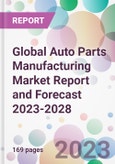Auto parts manufacturing encompasses the production of a myriad of components that constitute a vehicle, from the smallest screws to complete engine systems. These parts, whether for cars, trucks, or other types of vehicles, are fundamental for the efficient and safe operation of the vehicle. With the automotive sector continuously pushing boundaries, the importance of high-quality, innovative, and durable auto parts has become more pronounced than ever.
The trajectory of global auto parts manufacturing market growth is intrinsically tied to the automotive sector's evolution. As consumer preferences shift towards more fuel-efficient, technologically advanced, and sustainable vehicles, auto parts manufacturers have had to pivot and adapt. The rise in electric vehicles, for instance, has led to increased demand for batteries, electric drivetrains, and advanced sensor systems.
Furthermore, the ever-growing importance of safety has necessitated advancements in auto parts related to accident prevention and mitigation. Advanced Driver Assistance Systems (ADAS) and the journey towards autonomous driving have placed the spotlight on sensors, radars, and complex electronic systems, propelling the auto parts manufacturing market development.
Another significant growth driver is the increasing global vehicle production, buoyed by emerging economies. With regions like Asia Pacific witnessing an uptick in vehicle ownership rates, the demand for auto parts for both new vehicles and aftermarket replacements has seen a substantial rise.
The integration of technology and digital transformation in vehicles has also opened up new avenues for auto parts manufacturers. Connectivity, infotainment systems, and the integration of artificial intelligence (AI) in modern vehicles are not only redefining the driving experience but also reshaping the auto parts manufacturing landscape.
In the sustainability realm, the auto parts manufacturing market are witnessing a gradual shift towards eco-friendly materials and processes. The push for reduced carbon footprints and minimal environmental impact is leading to the research and adoption of green materials and manufacturing techniques. This transition not only meets regulatory standards but also resonates with an increasingly eco-conscious consumer base.
Market Segmentation
The market can be divided based on component, sales channel, vehicle type, and region.Market Breakup by Component
- Battery
- Cooling System
- Compressor
- Radiator
- Pump
- Thermostat
- Underbody Components
- Brake Components
- Exhaust Components
- Engine Components
- Starter
- Pump
- Engine
- Alternator
- Automotive Filter
- Lighting Components
- Electrical Components
- Ignition Coil
- Ignition Switch
- Spark and Glow Plug
- Chassis System
- Transmission and Steering System
- Others
Market Breakup by Sales Channel
- OEM
- Aftermarket
Market Breakup by Vehicle Type
- Passenger Cars
- Light Commercial Vehicles
- Heavy Commercial Vehicles
- Others
Market Breakup by Region
- North America
- Europe
- Asia Pacific
- Latin America
- Middle East and Africa
Competitive Landscape
This report looks into the market shares, plant turnarounds, capacities, investments, and acquisitions and mergers, among other major developments, of the global auto parts manufacturing companies. Some of the major key players explored in the report are as follows:- Robert Bosch GmbH
- DENSO CORPORATION
- Continental AG
- ZF Friedrichshafen AG
- Hyundai Motor Group
- Aisin Corporation
- Magna International Inc
- Valeo
- Lear Corporation
- Yazaki Group
- Tenneco Inc
- Sumitomo Electric Industries, Ltd
- Akebono Brake Industry Co., Ltd
- Panasonic Holdings Corporation
- Faurecia S.E
- Marelli Holdings Co., Ltd
- Others
About the Publisher
Acquire unparalleled access to critical industry insights with our comprehensive market research reports, meticulously prepared by a team of seasoned experts. These reports are designed to equip decision-makers with an in-depth understanding of prevailing market trends, competitive landscapes, and growth opportunities.This high-quality, data-driven analyses provide the essential framework for organisations seeking to make informed and strategic decisions in an increasingly complex and rapidly evolving business environment. By investing in our market research reports, you can ensure your organisation remains agile, proactive, and poised for success in today's competitive market.
Don't miss the opportunity to elevate your business intelligence and fortify your strategic planning. Secure your organisation's future success by acquiring one of these reports today.
*The publisher always strives to provide you with the latest information. The numbers in the article are only indicative and may be different from the actual report.
Table of Contents
Companies Mentioned
- Robert Bosch GmbH
- DENSO CORPORATION
- Continental AG, ZF
- Friedrichshafen AG
- Hyundai Motor Group
- Aisin Corporation
- Magna International Inc.
- Valeo
- Lear Corporation
- Yazaki Group
- Sumitomo Electric Industries, Ltd.
- Tenneco Inc.
- Akebono Brake Industry Co., Ltd.
- Panasonic Holdings Corporation
- Faurecia S.E.
- Marelli Holdings Co., Ltd
Methodology

LOADING...
Table Information
| Report Attribute | Details |
|---|---|
| No. of Pages | 169 |
| Published | July 2023 |
| Forecast Period | 2023 - 2028 |
| Estimated Market Value ( USD | $ 693.31 Billion |
| Forecasted Market Value ( USD | $ 939.21 Billion |
| Compound Annual Growth Rate | 6.2% |
| Regions Covered | Global |
| No. of Companies Mentioned | 16 |









